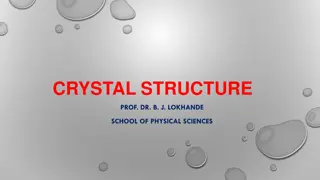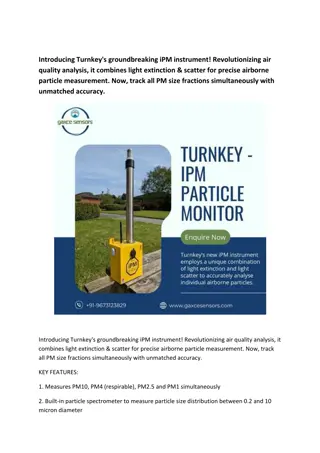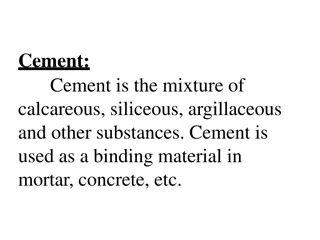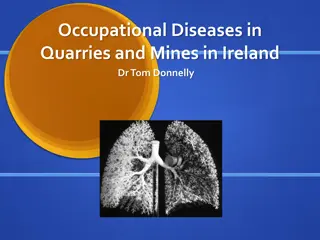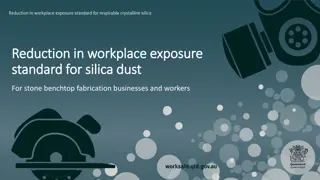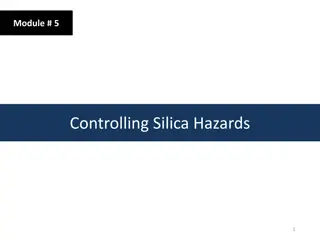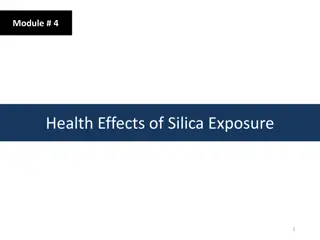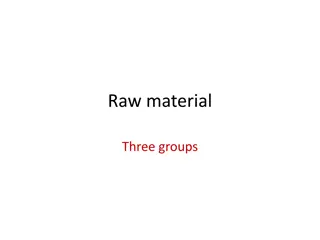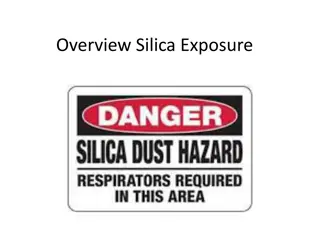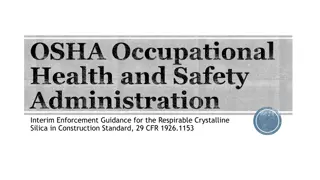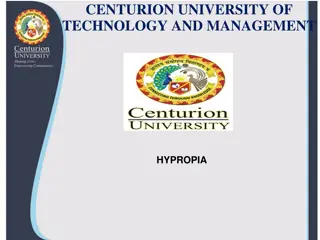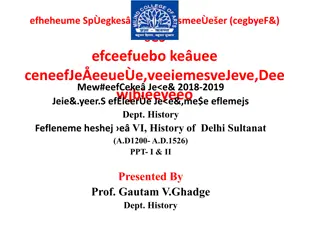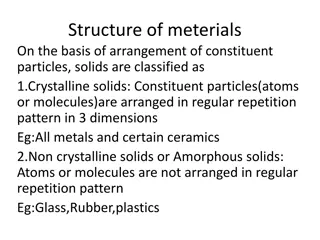Respirable Crystalline Silica
Respirable Crystalline Silica, found in various materials like concrete and sandstone, poses serious health risks when inhaled. Exposure can lead to silicosis, lung cancer, kidney disease, and other respiratory issues. This hazardous substance primarily affects workers in construction and general industries. It's crucial to understand the risks associated with silica exposure and take preventive measures to safeguard workers' health.
Download Presentation

Please find below an Image/Link to download the presentation.
The content on the website is provided AS IS for your information and personal use only. It may not be sold, licensed, or shared on other websites without obtaining consent from the author.If you encounter any issues during the download, it is possible that the publisher has removed the file from their server.
You are allowed to download the files provided on this website for personal or commercial use, subject to the condition that they are used lawfully. All files are the property of their respective owners.
The content on the website is provided AS IS for your information and personal use only. It may not be sold, licensed, or shared on other websites without obtaining consent from the author.
E N D
Presentation Transcript
Respirable Crystalline Silica - PART 690, 1926.1153 CONSTRUCTION - PART 590, 1910.1053 GENERAL INDUSTRY
Respirable Crystalline Silica Where can it be found: Concrete Masonry Sandstone Rock Paint Abrasives Mortar Plaster Shingles Soil
Health Effects - Silica Early stages of the disease may go unnoticed. Silicosis disabling, non-reversible & sometimes fatal lung disease. Other non-malignant respiratory diseases, such as chronic bronchitis. Lung Cancer Kidney disease including nephritis & end-stage renal disease (kidneys). May be associated with auto-immune disorders & cardiovascular disease. Symptoms include: Shortness of breath Severe cough Chest pains Weakness
Silica magnified Inside alveoli Crystalline silica causes scar tissue inside the alveoli, blocking the transfer of gases to and from the blood.
Warning! Warning! Silicosis IS NOT CURABLE, but it IS PREVENTABLE. Don t be like THAT guy!
Scope & Application Part 590, 1910.1053 General Industry Applies to all occupational exposures to respirable crystalline silica, except: Construction work Agricultural Operations Processing sorptive clays (like kitty litter) This section does not apply where the employer has objective data demonstrating that employee exposure to respirable crystalline silica will remain below 25 micrograms per cubic meter of air (25 g/m ) as an 8-hour time-weighted average (TWA) under any foreseeable conditions. This section means this respirable crystalline silica std. 29 CFR 1910.1053.
Scope & Application General Industry (Part 590, 1910.1053) This section does not apply if the employer complies with 29 CFR 1926.1153 (construction rule) and: The task performed is indistinguishable from a construction task listed on Table 1 in paragraph (c) of 29 CFR 1926.1153 (Construction); and The task will not be performed regularly in the same environment and conditions (non- routine tasks).
Scope & Application Part 690, 1926.1153 Construction This section applies to all occupational exposures to respirable crystalline silica in construction work, except where employee exposure will remain below 25 micrograms per cubic meter of air (25 g/m ) as an 8-hour time-weighted average (TWA) under any foreseeable conditions. This section means this respirable crystalline silica std. 29 CFR 1926.1153.
Definitions Action Level = 25 g/m (0.025 mg/m ) Permissible exposure limit (PEL) = 50 g/m (0.050 mg/m ) Employee exposure = Means the exposure to airborne respirable crystalline silica that would occur if the employee were not using a respirator. High-efficiency particulate air [HEPA] filter = Means a filter that is at least 99.97 percent efficient in removing mono-dispersed (a uniform collection of size) particles of 0.3 micrometers in diameter. Objective data = means information (air monitoring data) from industry wide surveys/calculations based on the composition of a substance, demonstrating employee exposure to respirable crystalline silica associated with a particular product/material/task/activity. Data must reflect workplace conditions closely resembling or with a higher exposure potential than the processes, types of material, control methods, work practices, and environmental conditions in the employer s current operations.
Definitions Competent person (construction) = means an individual who is capable of identifying existing and foreseeable respirable crystalline silica hazards in the workplace and who has the authorization to take prompt corrective measures to eliminate or minimize them. The competent person must have knowledge and ability necessary to fulfill the responsibilities set forth in paragraph (g) of this section. By way of training and/or experience, a competent person is knowledgeable of applicable standards, is capable of identifying workplace hazards relating to the specific operation, and has the authority to correct them. - There are currently no specific standards regarding competent person requirements.
Definitions Physician or other licensed health care professional [PLHCP] = means an individual whose legally permitted scope of practice (i.e., license, registration, or certification) allows him or her to independently provide or be delegated the responsibility to provide some or all of the particular health care services required by paragraph (h) of this section. Regulated area (GI) = means an area, demarcated by the employer, where an employee s exposure to airborne concentrations of respirable crystalline silica exceeds, or can reasonably be expected to exceed, the PEL. Respirable crystalline silica = means quartz, cristobalite, and/or tridymite contained in airborne particles that are determined to be respirable by a sampling device designed to meet the characteristics for respirable-particle-size-selective samplers specified in the international Organization for Standardization (ISO) 7708:1995: Air Quality Particle Size Fraction Definitions for Health-Related Sampling.
Specified Exposure Control Methods Construction For each employee engaged in a task identified on Table 1, the employer shall fully and properly implement the engineering controls, work practices, and respiratory protection specified for the task on Table 1, unless the employer assesses and limits the exposure of the employee to respirable crystalline silica in accordance with paragraph (d) of this section (Alternate exposure control methods).
Table 1: Specified Exposure Control Methods When Working With Materials Containing Crystalline Silica -Construction REQUIRED RESPIRATORY PROTECTION & MINIMUM ASSIGNED PROTECTION FACTOR (APF) 4 hours/shift EQUIPMENT/TASK/CONTROL METHODS 4 hours/shift Stationary Masonry Saws Continuous water feed to blade None None Handheld power saws (any blade diameter) Continuous water feed to blade Outdoors Indoors/enclosed area None APF 10 APF 10 APF 10 Handheld power saws for cutting fiber cement board (blade diameter 8 inches) Outdoor use only Dust collection system (commercial) Proper tool airflow & HEPA filters ( 99%) None None
Table 1: Specified Exposure Control Methods When Working With Materials Containing Crystalline Silica REQUIRED RESPIRATORY PROTECTION & MINIMUM ASSIGNED PROTECTION FACTOR (APF) 4 hours/shift EQUIPMENT/TASK/CONTROL METHODS 4 hours/shift Walk-behind saws Continuous water feed to blade Outdoors Indoors/enclosed area Drivable saws Outdoors only Continuous water feed to blade Rig-mounted core saws/drills Continuous water feed to blade None None APF 10 APF 10 None None None None
Table 1: Specified Exposure Control Methods When Working With Materials Containing Crystalline Silica REQUIRED RESPIRATORY PROTECTION & MINIMUM ASSIGNED PROTECTION FACTOR (APF) 4 hours/shift EQUIPMENT/TASK/CONTROL METHODS 4 hours/shift Handheld & Stand-mounted drills (include impact/rotary hammer drills) Shroud/cowling equipped drill Dust collection 99% w/ filter cleaning mechanism HEPA filtered vac for cleaning holes None None Dowel drilling rigs for concrete Outdoors only Shroud/cowling around drill bit Dust collection 99% w/ filter cleaning mechanism APF 10 APF 10
Table 1: Specified Exposure Control Methods When Working With Materials Containing Crystalline Silica REQUIRED RESPIRATORY PROTECTION & MINIMUM ASSIGNED PROTECTION FACTOR (APF) 4 hours/shift EQUIPMENT/TASK/CONTROL METHODS 4 hours/shift Vehicle-mounted drilling rigs for rock/concrete Dust collection system w/ close capture hood/shroud around drill bit w/ low-flow water spray to wet dust at discharge point from dust collector Or Operate from within an enclosed cab and use water for dust suppression on drill bit None None None None
Table 1: Specified Exposure Control Methods When Working With Materials Containing Crystalline Silica REQUIRED RESPIRATORY PROTECTION & MINIMUM ASSIGNED PROTECTION FACTOR (APF) 4 hours/shift EQUIPMENT/TASK/CONTROL METHODS Jackhammers & handheld power chipping tools Continuous stream/spray of water at point of impact When used outdoors Indoors/enclosed areas Or Equipped w/ commercially available shroud & dust collection system Filter w/ 99% filter w/ filter- cleaning mechanism When used outdoors Indoors/enclosed areas 4 hours/shift None APF 10 APF 10 APF 10 None APF 10 APF 10 APF 10
Table 1: Specified Exposure Control Methods When Working With Materials Containing Crystalline Silica REQUIRED RESPIRATORY PROTECTION & MINIMUM ASSIGNED PROTECTION FACTOR (APF) 4 hours/shift EQUIPMENT/TASK/CONTROL METHODS 4 hours/shift Handheld grinders for mortar removal (i.e., tuckpointing) Equipped w/ commercially available shroud & dust collection Dust collector must provide 25 cfm per inch of wheel diameter Filter w/ 99% efficiency Cyclonic pre-separator or filter-cleaning mechanism APF 10 APF 25
Table 1: Specified Exposure Control Methods When Working With Materials Containing Crystalline Silica EQUIPMENT/TASK/CONTROL METHODS REQUIRED RESPIRATORY PROTECTION & MINIMUM ASSIGNED PROTECTION FACTOR (APF) Handheld grinders for uses other than mortar removal Performed outdoors only Equipped w/ integrated water delivery system for continuous water feed to the grinding surface Or Equipped w/ commercial shroud & dust collection Dust collector must provide 25 cfm of airflow per inch of wheel diameter Filter w/ 99% efficiency Use cyclonic pre-separator or filter cleaning mechanism When used outdoors Indoors/enclosed areas 4 hours/shift 4 hours/shift None None None None None APF 10
Table 1: Specified Exposure Control Methods When Working With Materials Containing Crystalline Silica REQUIRED RESPIRATORY PROTECTION & MINIMUM ASSIGNED PROTECTION FACTOR (APF) 4 hours/shift EQUIPMENT/TASK/CONTROL METHODS 4 hours/shift Walk-behind milling machines & floor grinders Equipped w/ integrated water delivery system Continuous water feed to cutting surface None None Or Equipped w/ dust collection system recommended by Mfg. Dust collection must provide air flow recommended by Mfg Filter 99% efficiency (HEPA) Filter-cleaning mechanism Indoors/enclosed areas HEPA vac to remove loose dust between passes None None
With Controls No Controls
Table 1: Specified Exposure Control Methods When Working With Materials Containing Crystalline Silica REQUIRED RESPIRATORY PROTECTION & MINIMUM ASSIGNED PROTECTION FACTOR (APF) 4 hours/shift EQUIPMENT/TASK/CONTROL METHODS 4 hours/shift Small drivable milling machines (less than half- lane) Equipped w/ supplemental water sprays designed to suppress dust Water must be combined w/ surfactant Operate & maintain machine to minimize dust emissions None None
Table 1: Specified Exposure Control Methods When Working With Materials Containing Crystalline Silica REQUIRED RESPIRATORY PROTECTION & MINIMUM ASSIGNED PROTECTION FACTOR (APF) 4 hours/shift EQUIPMENT/TASK/CONTROL METHODS 4 hours/shift Large drivable milling machines (half- lane & larger) For cuts of any depth on asphalt only: Equipped w/ exhaust ventilation on drum enclosure AND Equipped w/ supplemental water sprays designed to suppress dust Operate & maintain machine to minimize dust emissions For cuts of four inches in depth or less on any substrate: Equipped w/ exhaust ventilation on drum enclosure AND Equipped w/ supplemental water sprays designed to suppress dust Operate & maintain to reduce emissions None None None None
Table 1: Specified Exposure Control Methods When Working With Materials Containing Crystalline Silica REQUIRED RESPIRATORY PROTECTION & MINIMUM ASSIGNED PROTECTION FACTOR (APF) 4 hours/shift EQUIPMENT/TASK/CONTROL METHODS 4 hours/shift Large drivable milling machines (half-lane & larger) continued For cuts of four inches in depth or less on any substrate: Equipped w/ supplemental water spray designed to suppress dust Water must be combined w/ surfactant Operate/maintain to minimize dust emissions None None
Table 1: Specified Exposure Control Methods When Working With Materials Containing Crystalline Silica REQUIRED RESPIRATORY PROTECTION & MINIMUM ASSIGNED PROTECTION FACTOR (APF) 4 hours/shift EQUIPMENT/TASK/CONTROL METHODS 4 hours/shift Crushing machines Equipment designed to deliver water spray/mist for dust suppression at crusher & other points where dust is generated (e.g., hoppers, conveyors, sieves/sizing, vibrating components, and discharge points) Operate/maintain to minimize emissions Ventilated booth w/ fresh, climate-controlled air to the operator, or remote station None None
Table 1: Specified Exposure Control Methods When Working With Materials Containing Crystalline Silica REQUIRED RESPIRATORY PROTECTION & MINIMUM ASSIGNED PROTECTION FACTOR (APF) 4 hours/shift EQUIPMENT/TASK/CONTROL METHODS 4 hours/shift Heavy Equipment/utility vehicles used to abrade/fracture silica-containing materials (e.g., hoe-ramming, rock ripping) or used during demolition activities involving silica- containing materials Operators in enclosed cabs Employees outside of cab that are engaged in the task apply water/dust suppressants as necessary to minimize dust emissions None None None None
Hoe Ramming Rock Ripping
Table 1: Specified Exposure Control Methods When Working With Materials Containing Crystalline Silica REQUIRED RESPIRATORY PROTECTION & MINIMUM ASSIGNED PROTECTION FACTOR (APF) 4 hours/shift EQUIPMENT/TASK/CONTROL METHODS 4 hours/shift Heavy equipment & utility vehicles for tasks such as grading & excavating but not including: demolishing, abrading, or fracturing silica-containing materials Apply water and/or dust suppressants as necessary to minimize dust emissions None None Or When the equipment operator is the only employee engaged in the task, operate equipment from within an enclosed cab None None
No local ventilation/water control Water/Local ventilation being used
Respiratory Protection is Also Required. (e)(1)(ii) For tasks not listed in Table 1 OR When the employer does not fully and properly implement the engineering controls, work practices and respiratory protection described in Table 1, where exposures exceed the PEL
Exposure assessment G.I. General Industry (d)(1) General. The employer shall assess the exposure of each employee who is or may reasonably be expected to be exposed to respirable crystalline silica at or above the action level in accordance with either the performance option in paragraph (d)(2) or the scheduled monitoring option in paragraph (d)(3) of this section. (2) Performance option. The employer shall assess the 8-hour TWA exposure for each employee on the basis of any combination of air monitoring data or objective data sufficient to accurately characterize employee exposures to respirable crystalline silica. (3) Scheduled monitoring option. (i) The employer shall perform initial monitoring to assess the 8-hour TWA exposure for each employee on the basis of one or more personal breathing zone air samples that reflect the exposures of employees on each shift, for each job classification, in each work area. Representative sampling is acceptable, must sample employees who are expected to have the highest exposure to respirable crystalline silica.
Exposure Assessment G.I. (ii) If initial monitoring < A.L. (25 g/m ), employer may discontinue monitoring of the represented employees for that exposure. (iii) Where the most recent exposure monitoring A.L. but PEL (50 g/m ), the employer shall repeat such monitoring within six months of the most recent monitoring. (iv) Where the most recent exposure monitoring > PEL, repeat monitoring within 3 months of the most recent. (v) Where the most recent (non-initial) exposure monitoring < A.L., employer shall repeat such monitoring within 6 months of the most recent monitoring until 2 consecutive measurements, taken 7 or more days apart, are < A.L., employer may discontinue monitoring for those employees represented by such monitoring, except as otherwise provided in paragraph (d)(4) of this section. (4) Reassessment of exposures. The employer shall reassess exposures whenever a change in the production, process, control equipment, personnel, or work practices may reasonably be expected to result in new or additional exposures at or above the A.L., or when the employer has any reason to believe that the new or additional exposures at or above the A.L. have occurred.
Employee Notification of Assessment Results Within 15 working days after completing an exposure assessment; Employer shall individually notify each affected employee in writing of the results. Employer can post results in appropriate location accessible to all affected employees. If exposures exceed the PEL, the employer shall describe in writing the corrective action being taken to reduce exposures. Observation of monitoring Affected employees or their designated reps have the option to observe the air monitoring. Observers must comply with the PPE requirements of the area.
Regulated Areas Establishment The employer shall establish a regulated area wherever an employee s exposure to airborne concentrations of respirable crystalline silica is, or can reasonably be expected to be, in excess of the PEL. Demarcation The employer shall demarcate areas from the rest of the workplace in a manner that minimizes the number of employees exposed to silica within the regulated area. The employer shall post signs at all entrances to regulated areas that bear the legend specified in paragraph (j)(2) of this section. Access The employer shall limit access to regulated areas to: Persons authorized and required by work duties to be present. Designated representatives exercising the right to observe. Any person authorized by the Occupational Safety and Health Act
Methods of Compliance Engineering & Work Practice Controls The employer shall use engineering and work practice controls to reduce and maintain employee exposures to or below the PEL unless determined to be not feasible. Employer must use engineering controls regardless of feasibility. Employer will supplement engineering controls with respiratory protection. Written Exposure Control Plan The employer shall establish and implement a written exposure control plan that contains at least the following: A description of the tasks in the workplace that involve exposure to respirable crystalline silica. A description of engineering controls, work practices, and respiratory protection used to limit exposures to silica. A description of the housekeeping measures used to limit employee exposures. The Written Exposure Control Plan shall be review and evaluated annually The Written Exposure Control Plan shall be readily available for review and copy.
Abrasive Blasting Employer must comply with requirements of paragraph (f)(1) of this section, and other OSHA standards. Ventilation (29 CFR 1910.94) Mechanical paint removers (29 CFR 1915.34) Personal Protective Equipment (29 CFR 1915 Subpart I) When using silica as a blasting agent or When removing material from substrates that contain silica.




